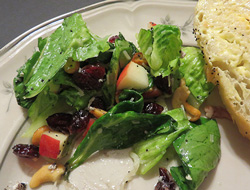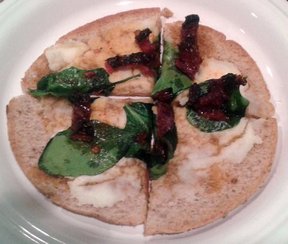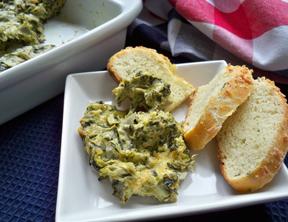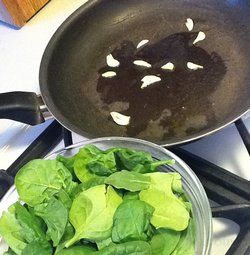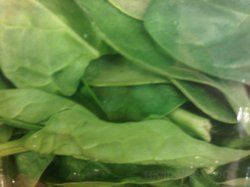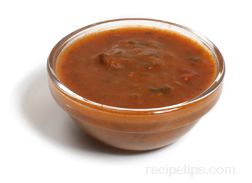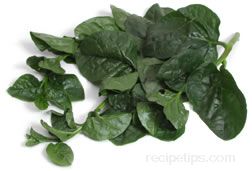A leafy green vegetable or salad green with a flavor that is slightly bitter tasting, derived from the oxalic acid contained in spinach. There are basically two different varieties of spinach grown for consumption: the small, smooth, flat-textured leaf spinach and the crinkle-textured broad leaf spinach. The flavor is the same for each variety, but the density or size of the leaves, the shape and texture of the leaves and the stalks all differ. Spinach is rich in potassium, iron, riboflavin, vitamin A, and vitamin C. When eaten raw, the nutrients are retained, however when cooked, spinach releases some of the nutrients into the liquid produced. By boiling the spinach greens, the nutrients are released into the water. However, when sautéed or steamed, the juices can be used in the cooked spinach so the nutrients can be retained. Spinach is served raw as a green for salads, cooked as a vegetable dish, or combined with other ingredients for a side dish. It is also dried, chopped into bits, and mixed with other ingredients to be used as a food seasoning. There are four types of spinach often available which include the common spinach, New Zealand spinach, Chinese or Asian Spinach, and Water Spinach. Common spinach has flat thin leaves, thin stalks and a medium green color. When eaten raw or cooked, the stalks are typically removed and the leaves are prepared for consumption. New Zealand spinach is a coarser, thicker leaf with a crinkled-texture. The leaf has an arrowhead shape with a fine fuzz covering the leaf, while the stalk is thicker than common spinach. The New Zealand spinach is best served as a cooked vegetable or ingredient to a food dish, providing a mellow grassy flavor. Chinese spinach is also referred to as Asian, Bayam, Ceylon, Malabar, Tampala, or Vietnamese spinach, as well as alogvati, mong toi, saan choy, or yin tsoi. This type of spinach provides a crinkle-textured, thicker leaf grown on a denser stalk than common spinach. It is a variety that is commonly grown in Asia and India for both the stalks and the leaf.
Fresh, frozen, canned, or dried, spinach in one form or another is available throughout the year. When selecting fresh spinach, choose leaves and stalks that are dark green and crisp, avoiding limp and damaged looking greens or leaves with yellow spots. To store, place the fresh spinach in a plastic bag and refrigerate for approximately three days or less. Spinach has a tendency to be gritty so it should be rinsed thoroughly before being served.
Loading
Spinach
USDA Nutrition Facts | |||||||||||||||||||||||||||||||||||||||||||||||||||||||||||||||
|
|||||||||||||||||||||||||||||||||||||||||||||||||||||||||||||||
There currently aren't any reviews or comments for this term. Be the first!
Advertisement
Advertisement






